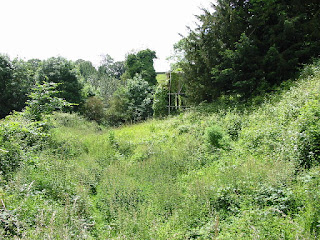First, I amazingly started with my childhood family tree in my baby book of my parents, grand parents and great grand parents only, which was 14 person's names. Now, I have over 10,000 names on the tree branches. It seems incredible, but some of the other trees on the internet are claiming, anywhere from 154,000 to 187,000 to 500,000 names.
As of April 25, 2013, I just recently received DNA results from ancestry.com because I was curious. According to their DNA testing, I am 72 % Scandinavian and 28 % Central European (French and German, mainly).
On 10/20/2013-Ancestry.com redid my DNA ethnicity estimate and I am now:
Scandinavian-30%; Western European-26%; Great Britain-24%; Ireland-17%; and others-
Finnish/Northern Russia region, Iberian Peninsula-3%.
This seems more realistic since it closer to my family tree.)On 12/7/2018, I have new DNA estimates:I am now Norway16%Sweden4%Great Britain-(includes France, Germany, north west Europe) 65%; Ireland/Scottish/Wales-15%; Iberian Peninsula-3%.})
And according to the entries in my ancestry.com family tree: my common ancestors are from the following countries:
USA 42%: England 37%; Sweden 12%; Ireland 9%: (I also have some common ancestors from France, Belgium, Netherlands, Germany, Spain, Italy, Czechoslovakia, Hungary, Turkey, Poland, Norway, Denmark, Luxembourg, Scotland, Wales)
Discrepancies between DNA and family trees are explained by ancestry.com:
"Your family tree may go back hundreds of years, but there could be more to your family’s story that’s just out of reach of paper documents and conventional research. Ancestry DNA can reach back hundreds, maybe even a thousand years, to tell you things that are not in historical records—things you might have never known otherwise. Although our ethnicity algorithms and prediction models will continue to improve over time, there are a few reasons why your ethnicity may not be exactly what you expected: 1. Your genetic ethnicity may go back further than your family tree. 2. While your ancestors lived in a certain country, there may have been genetic influence from other places. 3. You don’t necessarily share common DNA with all of your ancestors. "
I again recommend this web page regarding DNA and family trees: http://humphrysfamilytree.com/ca.html
Secondly, as I again have pointed out, I discovered that, what most genealogists and scientists apparently already know, that I have a lot of famous and historical figures as common ancestors.I studied history in college, and enjoy it still, so learning history again by following the family tree was interesting and fun.
I have already brought up a few of their names already.
The most famous were Charlemagne, William the Conqueror, five US presidents and Winston Churchill. I have reached many ancient kings, queens, noblemen and noble women along with their historical importance back to England, France, Germany, Italy, etc. Charlemagne and William the Conqueror were found on least twenty different family tree branches; twigs, actually. The last English king my tree reached was Edward III who died in 1377. According to the same website, http://humphrysfamilytree.com/ca.html, me and 100 million persons are descended from Edward III. Also, I mentioned this in my first post regarding the article about Brooke Shields.
During the recent events in Boston, I kept hearing about Boylston Street where the horrible events happened. The name sounded familiar, and I found it on my family tree. The Boylston family was a prominent New England family during Revolutionary times. And I assume that is why a street in Boston is named for them. My common ancestor to them was Thomas Gardner, who was my 11th generation Great-Grandfather and President John Adams Great-Great Grandfather and John Quincy Adams Great-Great-Great-Grandfather. We are related because Thomas Gardner, an English Immigrant, had a Granddaughter Mary Gardner, who married Thomas Boylston. Their son Peter Boylston and his wife Anne White had a daughter named Susanna Boylston, who was a Boston socialite. She married John Adams Sr., the father of John Adams and grandfather of John Quincy Adams.
I have common ancestors with Humphrey Bogart through two different branches. My 12th generation great-grandfather is William Churchill through the Hubbell branch of my tree, who is also the 9th generation great-grandfather of Humphrey Bogart on his mother's side, Maud Humphrey whose mother was Frances Churchill. Also, her common ancestors are the same as Winston Churchills.
Also, my 9th generation great-grandfather through Sarah Ferris branch was Nathaniel Baldwin who was Humphrey Bogarts 5th generation great-grandfather through his mother's father, John Perkins Humphrey, grandmother Rachel Dowd.
Also, I share common ancestors with David Cameron, (ex) PM of England. One common ancestor is Richard I, "Copped Hat" Fitzalan, Earl of Arundel and Surrey (1310-1376) who was his 17th GGF and my 19th GGF.
I have some of the richest persons in History as common ancestors. According to "Forbes Magazine", estimated and based on current inflation levels and currency, William the Conqueror, (my 24th GGF) was worth $229 Billion(# 7 on their list); William de Varennes, Warenne, 1st Earl of Surrey Seigneur de Varennes Warenne ( my 27th GGF) was worth $146 Billion, #13 on their list; Richard I, "Copped Hat" FitzAlan, 10th Earl of Arundel, (1310-1376) (my 19th GGF), estimated worth $118.6 Billion, (#15 on their list). John of Gaunt, 1st Duke of Lancaster, KG (6 March 1340 – 3 February 1399) , (#16), (my 20th GGF).
My common ancestors also, as I have already pointed out in previous posts, have owned a lot of property and lived in medieval castles and more modern mansions.
Castles of England and Europe
A fascinating book about the castles of England.
https://en.wikibooks.org/wiki/Castles_of_England/Print_Version
(Name and place of Castle-Common Ancestors who lived in it and Wikipedia address)
(all of them have very long histories of building and destruction and rebuilding, they all exist today in one form or another, and most can be visited)
Alnwick Castle: Alnwick, Northumberland, England- known as one of the castles used in the Harry Potter movies to represent Hogwarts, and it has been in many other movies and television shows, and therefore a favorite for visitors- Sir Henry Percy, 2nd Earl of Northumberland, (1393-1455) my 18th GGF, and Sir Henry "Hotspur" Percy, my 19th GGF.- http://en.wikipedia.org/wiki/Alnwick_Castle.
Amesbury is a town and civil parish in Wiltshire, England. It is most famous for the prehistoric monument of Stonehenge which is in its parish. Eleanor of Provence, Queen of England, born in 1217 and was buried in the Abbey of St Mary and St Melor, on 11 September 1291, my 22nd GGM http://en.wikipedia.org/wiki/Amesbury
Arundel Castle is a restored medieval castle in Arundel, West Sussex, England - From the 11th century onward, the castle has served as a hereditary stately home and has been in the family of the Duke of Norfolk for over 400 years. It is still the principal seat of the Norfolk family. - John FitzAlan, Earl of Arundel, Lord of Oswestry and Clun, II, (1223-1267)-the first in a long line of FitzAlans to live in this castle. My 22nd GGF- through Richard I, "Copped Hat" Fitzalan, 10th Earl of Arundel and Surrey (1310-1376) my 19th GGF, and his son, Sir Richard 11th Earl of Arundel, (1346-1397) - my 18th GGF- http://en.wikipedia.org/wiki/Arundel_Castle
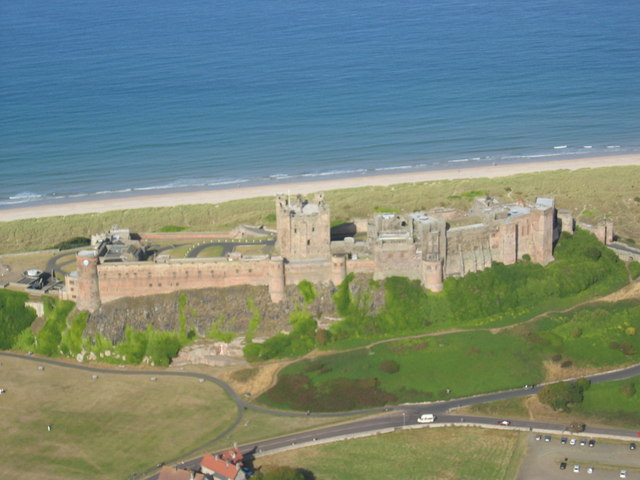
Bamburgh Castle is a castle on the northeast coast of England, by the village of Bamburgh in Northumberland. My 17th GGF Sir Ralph Percy (11 Aug 1425 – 25 Apr 1464) was a knight, and Governor of Bamburgh Castle. Bamburgh Castle has been used as a filming location for a number of television and film projects.
https://en.wikipedia.org/wiki/Bamburgh_Castle

Belvoir Castle is a stately home in the English county of Leicestershire, A Norman castle originally stood on the high ground. The castle was built on the land of Robert de Todeni, my 27th great uncle, of the Doomsday Book, and inherited from him by William d'Aubigny, my 28th GGF, and remained through a few more William d'Aubignys. Several films and television shows have used it as a location, notably the film Little Lord Fauntleroy starring Sir Alec Guinness, The Da Vinci Code, 1985 film Young Sherlock Holmes.
https://en.wikipedia.org/wiki/Belvoir_Castle

Berkeley Castle, Berkeley, Gloucestershire, England - The castle has remained within the Berkeley family since they reconstructed it in the 12th century, except for a period of royal ownership by the Tudors. It is traditionally believed to be the scene of the murder of King Edward II in 1327 - (born 1284) - my 19th GGF - and beginning with Robert `the Devout' FitzHarding, merchant of Bristol; 1st feudal Baron Berkeley,(1095-1171), my 25th GGF, and his decendants - and Roger de Berkeley I ( 1040-1093), my 30th GGF and his descendants - The castle is the oldest continuously occupied castle in England after the royal fortresses of the Tower of London and Windsor Castle, and the oldest to be continuously owned and occupied by the same family.
http://en.wikipedia.org/wiki/Berkeley_Castle

Beaumont Palace built outside the north gate of Oxford, Oxfordshire, England. King John, my 22nd GGF, was born here in 1167. It was intended by Henry I, my 23rd GGF, in about 1130 to serve as a royal palace conveniently close to the royal hunting-lodge at Woodstock (now part of the park of Blenheim Palace). Nothing remains of it but some pictures.
http://en.wikipedia.org/wiki/Beaumont_Palace
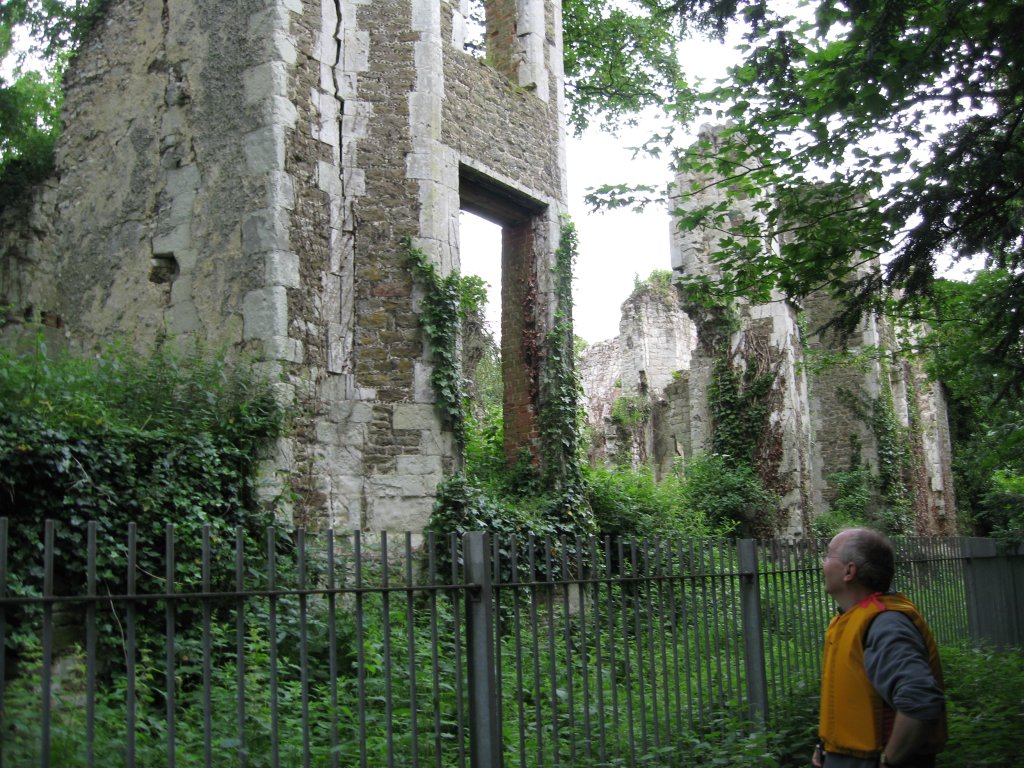
Betchworth Castle is a mostly crumbled ruin of a fortified medieval stone house with some tall, two-storey corners strengthened in the 18th century, in the north of the semi-rural parish of Brockham. It is built on a sandstone spur overlooking the western bank of the Mole in Surrey in England. It was was the seat of the manor of West Betchworth and was held by Richard de Tonbridge at the time of the Domesday Survey. It started as an earthwork fortress built by Robert Fitz Gilbert in the 11th century. It was granted in 1373 to Richard FitzAlan, 3rd or 10th Earl of Arundel. His son Sir John FitzAlan, Earl Marshall of England, turned it into a stone castle in 1379. It passed by marriage to Sir Thomas Browne, Sheriff of Kent, who in 1448 rebuilt it as a fortified house.Sir Thomas Brown(e) (my 16th GGF) was also Treasurer of the Household to King Henry
The castle is haunted by a black dog (death dog) that prowls the ruins at night, also the grounds of the castle (Betchworth Park golf course) is haunted by evil or unexplained things.
IV.https://en.wikipedia.org/wiki/Betchworth_Castle
Bolsover Castle is in the town of Bolsover, in the north-east of the English county of Derbyshire. Built in the early 17th century, the present castle lies on the earthworks and ruins of the 12th-century medieval castle; the first structure of the present castle was built between 1612 and 1617 by Sir Charles Cavendish. The site is now in the care of the English Heritage charity, as both a Grade I listed building and a Scheduled Ancient Monument.
Bramber Castle is a Norman motte-and-bailey castle formerly the caput of the large feudal barony of Bramber long held by the Braose family. It is situated in the village of Bramber, West Sussex, near the town of Steyning, overlooking the River Adur.Surveys indicate the Normans were the first to build a fortification in the area, around 1070. It served as the administrative hub of the newly created Rape of Bramber, and controlled the River Adur estuary. The castle was held by William de Braose, 1st Lord of Bramber,(my 25th GGF) whose family originated from Falaise.[1] He appears in the 1960 novel Knight's Fee, by Rosemary Sutcliff, who lived in Steyning.
Brancepeth Castle is a castle in the village of Brancepeth in County Durham, England,- founded by Aschetil de Bulmer, High Sheriff of Yorkshire, (1090-1129), my 29th GGF, and his descendants http://en.wikipedia.org/wiki/Brancepeth_Castle
Calverley Old Hall is a medieval manor house situated at Calverley, West Yorkshire, England. It belonged to the Calverley family for hundreds of years including two Johns and two Walter de Calverleys who were my 17th through 20th GGFs. They lived in the Thirteenth through the Fifteenth centuries. See http://en.wikipedia.org/wiki/Calverley_Old_Hall for a murder story regarding one of the Calverleys.
Carisbrooke Castle is a historic motte-and-bailey castle located in the village of Carisbrooke (near Newport), Isle of Wight, England. Charles I was imprisoned at the castle in the months prior to his trial. William FitzOsbern (my 26th GGF)was one of the major Norman castle builders. Early castles attributed to him include Carisbrooke Castle on the Isle of Wighthttps://en.wikipedia.org/wiki/Carisbrooke_Castle
Castle Acre Castle and town walls are a set of ruined medieval defences built in the village of Castle Acre, Norfolk.The castle was built soon after the Norman Conquest by William de Warenne, my 26th GGF, the Earl of Surrey, at the intersection of the River Nar and the Peddars Way. William constructed a motte-and-bailey castle during the 1070s, protected by large earthwork ramparts, with a large country house in the centre of the motte. William was a Norman lord who had accompanied William the Conqueror in the conquest of England in 1066; he was rewarded with extensive estates across England..
https://en.wikipedia.org/wiki/Castle_Acre_Castle_and_town_walls
Caus Castle is a ruin of a hill fort and medieval castle in the civil parish of Westbury in the English county of Shropshire. It is situated up on the eastern foothills of the Long Mountain guarding the route from Shrewsbury, Shropshire to Montgomery, Powys on the border between England and Wales. It was destroyed during the English Civil War and has been in ruins since. Roger le Corbet (or Fitz Corbet) (my 26th GGF.)was granted several manors in Shropshire in 1069 by William the Conqueror as the Barony of Caus for his role in the Norman conquest and invasion of England. They were named after his Normandy estate in the Pays de Caux, in France. The Corbets owed fealty to Roger de Montgomery, the first Earl of Shrewsbury to help control Welsh Marches with absolute control over their demesne. Caus Castle was built by Roger le Corbet in the late 11th century as a high motte with a very small summit on which stood a tower and a strongly defended inner bailey.
https://en.wikipedia.org/wiki/Caus_Castle

Chartley Castle lies in ruins to the north of the village of Stowe-by-Chartley in Staffordshire, between Stafford and Uttoxeter (grid reference SK010285). The remains of the castle and associated earthworks are a Scheduled Monument, the site having been protected since 1925.[1] The castle itself is a Grade II* listed building. The motte and bailey castle was built by one of the early Earls of Chester, about 1100, as a safe stop-over for their journeys to places such as Tutbury. It was rebuilt in 1220 by Ranulph de Blondeville, 4th Earl of Chester, who died in 1232. It then passed by marriage to William de Ferrers, 5th Earl of Derby.(my 21st GGF) It remained in the Ferrers family for more than 200 years,
https://en.wikipedia.org/wiki/Chartley_Castle
http://en.wikipedia.org/wiki/Ch%C3%A2teau_d%27Angers

Château de Chaumont (or Château de Chaumont-sur-Loire) is a castle in Chaumont-sur-Loire, Loir-et-Cher, France. The castle was founded in the 10th century by Odo I, Count of Blois.(28th GGF) in the 10th century, with the purpose of protecting his lands from attacks from his feudal rivals, Fulk Nerra, Count of Anjou.[2] On his behalf the Norman Gelduin received it, improved it and held it as his own. His great-niece Denise de Fougère, (my GGM)having married Sulpice d'Amboise, passed the château into the Amboise family (many GGFs) for five centuries.
see http://en.wikipedia.org/wiki/Ch%C3%A2teau_de_Chaumont
The Château de Domfront is a ruined castle in the town of Domfront, in the Orne département of France.
In 1051, the castle at Domfront, belonging to Guillaume II Talvas, lord of Bellême, and occupied by the forces of Geoffrey of Anjou, was besieged by William the Conqueror, duke of Normandy.[2] In 1092, the people of Domfront revolted against Robert II de Bellême, Earl of Shrewsbury, transferring their allegiance to the third son of William the Conqueror, Henri Beauclerc,(24th GGF)
https://en.wikipedia.org/wiki/Ch%C3%A2teau_de_Domfront

Château de Montlhéry is a castle in the commune of Montlhéry in the Essonne département of France. Ruins date from various periods, most notably the 10th, 11th, 13th and 14th centuries.The present 13th-century castle, with its prominent keep, succeeded a castle built in the 11th century, and an earlier foundation, built from 991 to 1015. The castle is a rectilinear pentagonal plan, with five surviving towers, one of which is much larger than the rest and serves as the keep, forming the point of the pentagon, at the end of the ridge. A gate tower protected the entrance on the opposite site. Recent evidence suggests that there may have a second court or bailey extending in front of the present gate, as well as a substantial chapel inside the presumed lower court.

Clare Castle is a medieval castle in the small town of Clare in Suffolk, England. Built shortly after the Norman conquest of England by Richard Fitz Gilbert, my 26th GGF.
https://en.wikipedia.org/wiki/Clare_Castle
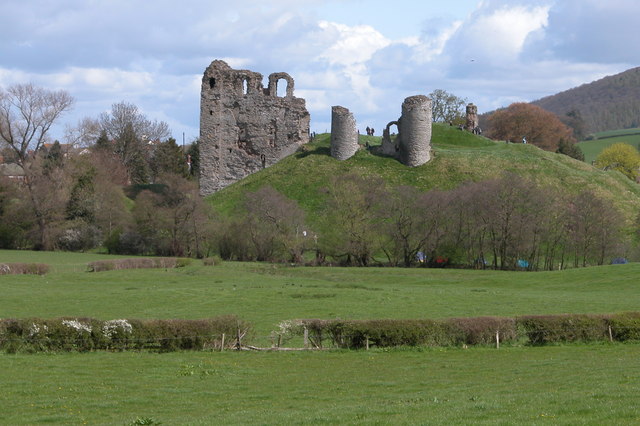
Clun Castle is a ruined castle in the small town of Clun, Shropshire, England - Owned for many years by the Fitzalan family, Clun played a key part in protecting the region from Welsh attack until it was gradually abandoned as a property in favour of the more luxurious Arundel Castle. Founded by Robert `Picot' de Say, FitzPicot, Lord of Clun, after Norman Invasion-my 28th GGF- through his Great-great granddaughter, Isabel de Saye, Baroness of Clun,(1114-1199), my 25th GGM, http://en.wikipedia.org/wiki/Clun_Castle

Corfe Castle, Corfe, Isle of Purbeck, Dorset, England -Built by William the Conqueror, my 27th GGF, and amongst early Norman Castles to use stone. The King hunted in the area around the Castle-others were William de Broase, Lord of Bramber,( 1175-1210), my 28th GGF,and his mother, Matilda de St. Valerie, Lady of Bramber (1155-1210), my 29th GGM. http://en.wikipedia.org/wiki/Corfe_Castle

Croft Castle is a castle, church and garden located at Yarpole, Herefordshire, England. A building has been on the site from the 11th century and it has from this time been the home of the Croft family and Croft baronets. These have included my 14th GGM, Elizabeth Croft and her father and GGF. https://en.wikipedia.org/wiki/Croft_Castle
Dolwyddelan Castle (Welsh: Castell Dolwyddelan) is a Welsh castle located near Dolwyddelan in Conwy County Borough in North Wales. It is thought to have been built in the early 13th century by Llywelyn the Great, Prince of Gwynedd and Wales. (1172-1240), My 22nd GGF. It was reputed to be the birthplace of Llywelyn the Great,
https://en.wikipedia.org/wiki/Dolwyddelan_Castle
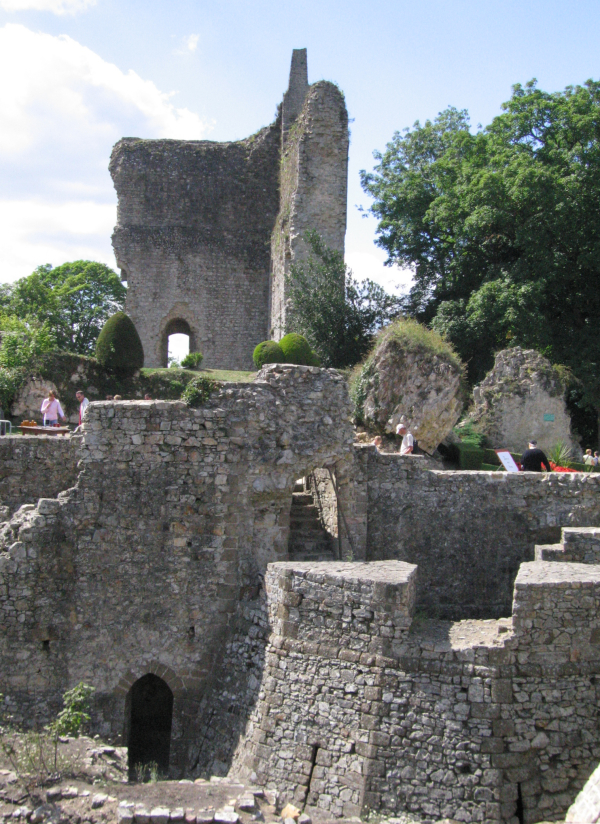
The Château de Domfront is a ruined castle in the town of Domfront, in the Orne département of France. Domfront being the personal possession of John Lackland,1204 King of England, my 20th GGF
https://en.wikipedia.org/wiki/Ch%C3%A2teau_de_Domfront

Dover Castle, Dover, Kent, England- It is the largest castle in England, famous for tunnels, hauntings and in movies and TV- Sir Bartholomew de Burghersh, 3rd Lord Burghersh, (1287-1355)- my 20th GGF- http://en.wikipedia.org/wiki/Dover_castle.

Dudley Castle is a ruined castle in the town of Dudley, West Midlands, England - Dudley Zoo is located in its grounds. Ansculf Ausculph de Picquigny from Picquigny, a Norman who took part on the Battle of Hastings, and William Fitz-Ansculf, his son, founded this castle, my 28th and 29th GGF; and also Stephen de Somery,(1100-1125), my 26th GGF and his descendants through my 22nd GGM, Lady Joan De Somery, Baroness Strange of Knockin (1232-1282). http://en.wikipedia.org/wiki/Dudley_Castle

Elmley Castle, Elmley, Worcestershire, England was a late 11th century earthwork and timber castle which received stone additions in the 12th and possibly 13th centuries. The ruins of this important Norman and medieval castle are located on the flanks of Bredon Hill, 1 km to the south of the village to which it gives its name. The castle is supposed to have been built for Robert 'le Despenser' d'Abetot,[1] Steward to William Rufus in the years following the death of William the Conqueror. Robert died childless (c 1098) and his sole heir was his brother Urse d'Abetot. Elmley Castle descended through those heirs to the powerful Beauchamp family with the marriage of Urse's daughter Emmeline d'Abetot, to Walter de Beauchamp, later called Walter of Elmley Castle. It remained the Beauchamp demense until William de Beauchamp my 20th GGF inherited the earldom and castle of Warwick from his maternal uncle, William Maudit, 8th Earl of Warwick, in 1268.
Ewyas Harold Castle, Ewyas Harold, Herefordshire, England- My 27th GGF, Ralph "the Timid", also known as Ralf of Mantes, 'the Staller', Earl Hereford, Norfolk,& Suffolk, (died 21 Dec 1057), a Saxon Lord, built, probably in 1048, and lived in the first castle on the site which is believed to be one of the very few which were built before the Norman conquest under the Saxons.
https://en.wikipedia.org/wiki/Ewyas_Harold_Castle
Gleaston Castle, Gleaston, Cumbria, England - Founded by Sir John Earl of Aldingham, 1st Baron of Harrington, (1281-1347), my 22nd GGF - http://en.wikipedia.org/wiki/Gleaston_Castle

Grandson Castle (French: Château de Grandson) is a medieval castle in the Swiss municipality of Grandson in the canton of Vaud. It is a Swiss heritage site of national significance.The Lords of Grandson were first mentioned in the second half of the 11th Century,[2] when the castle was built. It was sited on the shore of Lake Neuchâtel to control the coast road. The House of Grandson sired a number of powerful scions, Included were my 23rd GGF, Sir William, 1st Baron de
Grandson, my 24th GGF, Pierre,Seigneur de Grandson, and my 25th GGF, Ebal , Seigneur de Grandson,. Today the Château de Grandson survives as one of the best preserved medieval fortresses in the country.
https://en.wikipedia.org/wiki/Grandson_Castle
Harbottle Castle, Harbottle, Northumberland, England- a ruined medieval castle- Agnes Grey Baroness of Harbottle, ( 1365-1420), Sir Thomas 5th Lord Umfraville Sheriff of Northumberland, Captain of Roxburgh, Castle de Umfreville, Umfraville II, (1361-1391)- my 19th GGF/GGM-http://en.wikipedia.org/wiki/Harbottle_Castle.
https://en.wikipedia.org/wiki/Helmsley_Castle
Hoghton Tower, a Grade I listed building, and fortified manor house located about 0.7 miles (1 km) to the east of the village of Hoghton, Lancashire, England. It is the ancestral home of the de Hoghton family. The de Hoghtons are descended directly from Harvey de Walter, (my 25th GGF), one of the companions of William the Conqueror, and through the female line from Lady Godiva of Coventry, wife of Leofric, Earl of Mercia. ((my 27th GGM) http://en.wikipedia.org/wiki/Hoghton_Tower
Josselin Castle (French: Château de Josselin, Breton: Kastell Josilin, Latin: Castellum Joscelini) is a medieval castle at Josselin, in the Morbihan department of Brittany, France, first built in 1008 by Guéthénoc, viscount of Porhoët. (my 27th GGF). The town and castle were named after Guéthénoc's son, Goscelinus, and rebuilt at various times since. The current castle was built by Olivier V de Clisson after 1370. He had acquired the land as part of the dowry on his marriage to Margaret of Rohan.[1] It has been designated as a monument historique since 1928.
Guéthénoc (or Guithenoc), vicomte of Porhoët, Rohan and Guéméné, began to build the first castle on the site around the year 1008, choosing a rocky promontory overlooking the valley of the Oust. The new fortress was named after Guéthénoc's son, Goscelinus (or Josselin).The name is recorded in the Cartulary of Redon Abbey (1080) as castellum et castrum Goscelini, but already by 1108 it was appearing as Castellum Joscelini.
The site chosen for the castle was excellent from both military and commercial points of view. Since the 9th century, there had also existed an annual pilgrimage in September to the Basilica of Our Lady of the Bramble (Notre-Dame du Roncier), which added greatly to the wealth of the lords and people of Josselin
https://en.wikipedia.org/wiki/Josselin_Castle
Knockin Castle is situated in the village of Knockin on Shropshire. This was a motte and bailey castle founded by Guy le Strange, (my 29th GGF) between 1154 and 1160 and it remained the principal holding of the le Strange family for most of the Middle Ages. The castle was damaged in the First Barons' War during the reign of King John and then repaired by John le Strange (my 27th GGF.) It was described as being 'ruinous' in 1540.
Lathom House was a large country house at Lathom in Lancashire, England. A wooden castle is believed to have stood on the site in mediaeval times. The stone-built castle known as Lathom House, built by the Stanley family in 1496, had eighteen towers, and was surrounded by a wall six foot thick and a moat eight yards wide, its drawbridge defended by a gateway tower. In the centre of the site was a tall tower known as the Eagle Tower. My 15th GGF, Thomas 1st Earl of Derby, 18th Lord High Constable of England, Knight of the Garter, King of Mann, Stanley, (1435 – 29 July 1504), and 15th GGM Lady Eleanor Alianor Neville resided there.
http://en.wikipedia.org/wiki/Lathom_House

Lewes Castle stands at the highest point of Lewes, East Sussex, England. Built by William de Warenne, 1st Earl of Surrey, (1055-1088), my 26th GGF, the brother-in-law of William the Conqueror. William de Warenne and his descendants lived here. http://en.wikipedia.org/wiki/Lewes_Castle
Ludlow Castle is a ruined medieval fortification in the town of the same name in the English county of Shropshire, standing on a promontory overlooking the River Teme. The castle was probably founded by Walter de Lacy (my 27th GGF) after the Norman conquest and was one of the first stone castles to be built in England. During the civil war of the 12th century the castle changed hands several times between the de Lacys and rival claimants, and was further fortified with a Great Tower and a large outer bailey.
Lumley Castle is a 14th-century quadrangular castle at Chester-le-Street in the North of England, It is named for its original creator, Sir Ralph Lumley, (my 18th GGF) who converted his family manor house into a castle in 1389 after returning from wars in Scotland. However, after being implicated in a plot to overthrow Henry IV he was imprisoned and ultimately executed, forfeiting his lands to the Earl of Somerset. In 1421 the ownership of the castle reverted to Sir Ralph Lumley's grandson, Thomas.
The castle is believed to be one of the most haunted places in County Durham, which includes a story about a woman named Lily Lumley who married Ralph Lumley In reality, the said Ralph de Lumley, 1st Baron Lumley (c. 1360 – January 1400) was married to Eleanor Neville (my 18th GGM). But in a tale called The Lily of Lumley he has a previous wife. She was supposedly thrown down a well in the castle grounds by two priests for rejecting the Catholic faith, who then told Baron Lumley she left him to become a nun. Her ghost is said to float up from the well and haunts the castle.
https://en.wikipedia.org/wiki/Lumley_Castle
Melbourne Castle was a medieval castle in Melbourne, Derbyshire. It was built on the site of an earlier royal manor house that had provided accommodation for noblemen hunting in a nearby royal park in the reign of King John. Construction of the castle was started in 1311 by Thomas, 2nd Earl of Lancaster, and continued until 1322, shortly before his execution, but the work was never fully completed.Earl Thomas granted the manor to his steward, Robert de Holland,(my 20th GGF) in February 1308.[7] In 1311, Robert obtained a licence to crenellate from Edward II in order to fortify the manor house,[3] and the more modest earlier building was converted into a castle between 1311 and 1322. https://en.wikipedia.org/wiki/Melbourne_Castle

Middleham Castle in Wensleydale, in the county of North Yorkshire, England, was built by Robert Fitzrandolph, 3rd Lord of Middleham and Spennithorne, my 24th GGF, (born 1145), commencing in 1190. It was built near the site of an earlier motte and bailey castle
http://en.wikipedia.org/wiki/Middleham_Castle.

Mitford Castle is an English castle dating from the end of the 11th century and located at Mitford, Northumberland. My 24th GGFs through 29th GGFs, the Bertrams, lived there. In the late 11th century, it was an earthwork fortress of the Bertram family through the 13th century, when in 1215, it was seized by John de Balliol, King of Scotland's troops.
https://en.wikipedia.org/wiki/Mitford_Castle
https://en.wikipedia.org/wiki/Monmouth_Castle

Moreton Corbet Castle is an English Heritage property located near the village of Moreton Corbet, Shropshire, England, My 16th GGFs through 20th GGFs, the Corbets lived there from 13the century through today.
http://en.wikipedia.org/wiki/Moreton_Corbet_Castle

Mulgrave Castle, Whitby, Yorkshire, England. This ancient castle, was by legend founded by Wada, a 6th-century ruler of Hälsingland. - Emma De Fossard Lady Brancepeth, (1112-1144) my 28th GGM-and her father Robert Fossard (1068-1134) and Grandfather, Nigel Fossard (died 1120), alo my 29th and 30th GGF, lived in this castle as Barons of Mulgrave and founders of this castle that still exists, but a different building today. http://en.wikipedia.org/wiki/Mulgrave_Castle
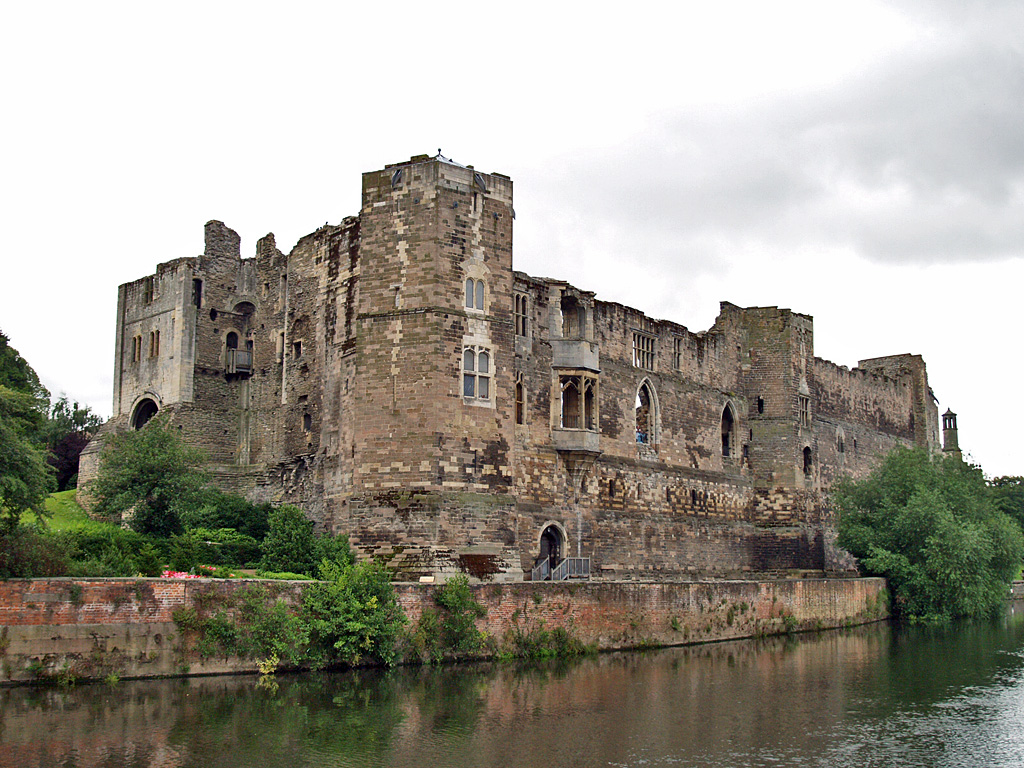
Newark Castle, in Newark-on-Trent, in the English county of Nottinghamshire was founded in the mid 12th century by Alexander, Bishop of Lincoln. King John, my 22nd GGF, died at this castle on the night of 18 October 1216. The Gilstrap Heritage Centre is a free-admission museum in the castle grounds about the history of the town of Newark. http://en.wikipedia.org/wiki/Newark_Castle,_Nottinghamshire

Ongar Castle is a good example of a late 11th- or early 12th-century motte and bailey, although only the earthworks survive. The motte or mound is about 70 metres in diameter at the base and is surrounded by a wet ditch up to 15 metres wide. A kidney-shaped inner bailey is to the west of the motte and there is a second bailey to the east. The remains of a town enclosure embankment extend to the west.
The castle may have been built by Eustace II, Count of Boulogne, who obtained the manor of Ongar in 1086. It was visited by King Henry II in 1157, when it was held by Richard de Lucy.(my 25th GGF) A stone keep was built on top of the motte, but this was pulled down in the 16th century and replaced by a brick building, itself destroyed in the 18th century. The motte itself is now covered with trees and is in private ownership, but can be seen from a public footpath that starts at the north end of the High Street.
https://en.wikipedia.org/wiki/Chipping_Ongar#Ongar_Castle

Orford Castle, Orford, Suffolk, England- described by historian R. Allen Brown as "one of the most remarkable keeps in England", is of a unique design- Robert, Lord Orford, de Valoines I (1221-1264) my 21st GGF-http://en.wikipedia.org/wiki/Orford_Castle.
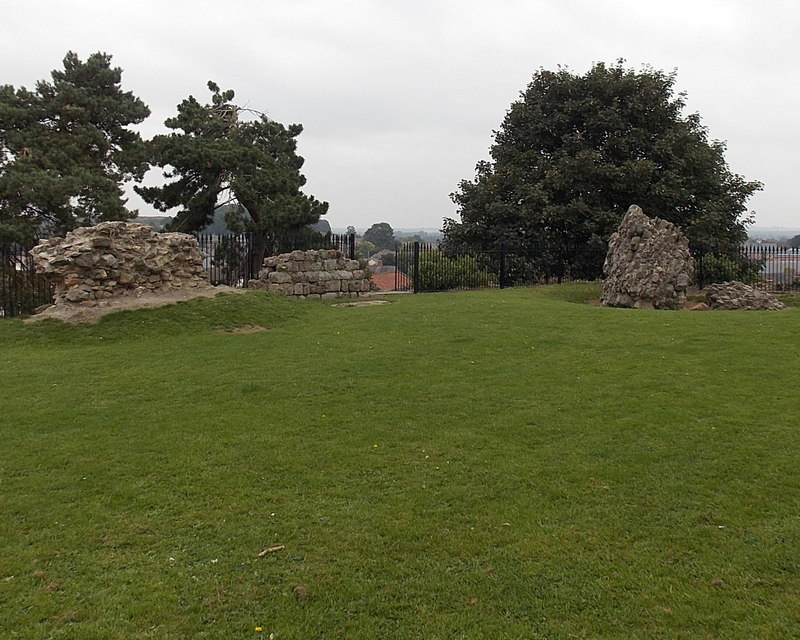
Oswestry Castle, Oswestry, Shropshire, England,- was built by Alan fitz Flaad (c.1078 – after 1121), (my 26th GGF) )Breton knight, was granted the feudal barony of Oswestry by King Henry I. He is now noted as the progenitor of the FitzAlan family, the Earls of Arundel (1267–1580), and the House of Stuart, although his family connections were long a matter of conjecture and controversy.William, Lord of Oswestry FitzAlan,my 25th GGF lived there,
Pembroke Castle (Welsh: Castell Penfro) is a medieval castle in the centre of Pembroke, Pembrokeshire in Wales. The castle was the original family seat of the Earldom of Pembroke. .A Grade I listed building since 1951, it underwent major restoration during the early 20th centuryThe castle was established at the heart of the Norman-controlled lands of southwest Wales.[4] Arnulf de Montgomery appointed Gerald de Windsor (my 25th GGF)

Pevensey Castle, Pevensey, East Sussex, England- a medieval castle and former Roman fort built in around A.D. 290- William de Warenne 1st Earl of Surrey, Seigneur de Varennes, (1055-1088)- my 30th GGF - http://en.wikipedia.org/wiki/Pevensey_Castle.

Portchester Castle is a medieval castle built within a former Roman fort at Portchester to the east of Fareham in the English county of Hampshire. It is located at the northern end of Portsmouth Harbour. Portchester Castle is rumoured to be haunted. Sir Hugh le Desp.enser, Lord of Loughborough, High Sheriff of Berkshire, Staffordshire, Shropshire I. (1197-1238), my 28th GGF, is reported to have been instrumental in the repairs of 1232 to Porchester Castle. http://en.wikipedia.org/wiki/Portchester_Castle

Prudhoe Castle, is a ruined medieval English castle situated on the south bank of the River Tyne at Prudhoe, Northumberland, England. Founded by Robert, Baron Prudhoe, De Umfreville, (1060-1120), my 27th GGF, and his descendants through Sir Thomas de Umfreville, Baron of Hessle Yorkshire and Holmside Durham, (1322-1387), my 20th GGF. http://en.wikipedia.org/wiki/Prudhoe_Castle
Raby Castle is a medieval castle located near Staindrop in County Durham, England, among 200 acres (810,000 m2) of deer park.[1] It was built by John Neville, 3rd Baron Neville de Raby, (my 20th GGF) between approximately 1367 and 1390. Cecily Neville, the mother of the Kings Edward IV and Richard III, was born here.
https://en.wikipedia.org/wiki/Raby_Castle
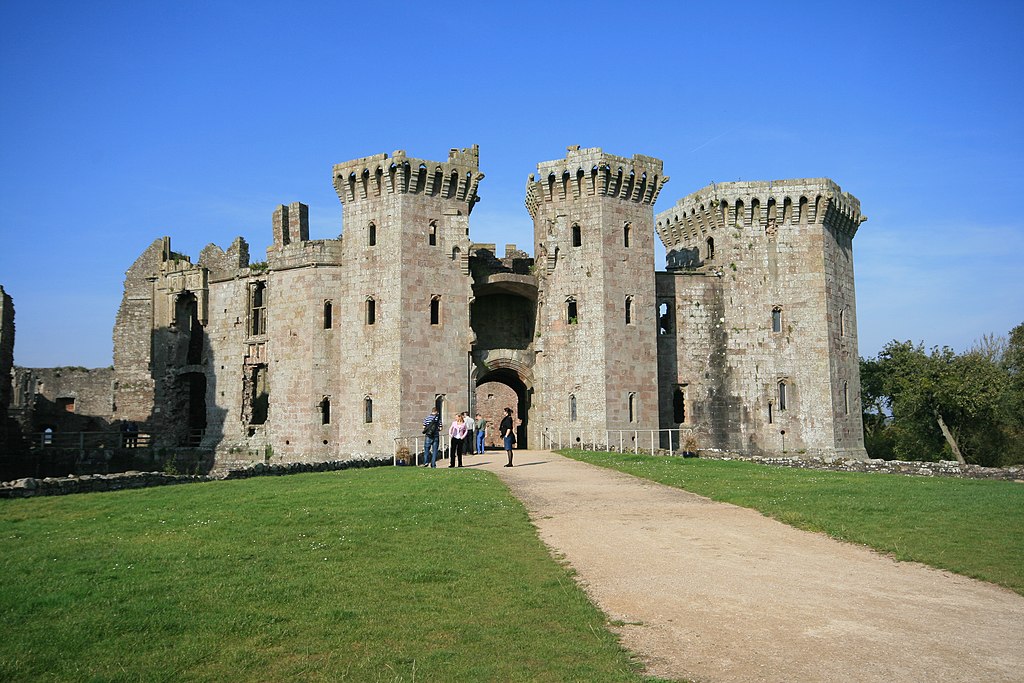

Rayleigh Castle (also known as Rayleigh Mount) was a masonry and timber castle built near the town of Rayleigh in Essex, England in the 11th century shortly after the Norman conquest. All that exists today are the earthwork remains of its large motte-and-bailey. Domesday Survey of 1086 records that Swein (other spellings are Sweyn, Sweyne, and Suen) my 28th GGF, built the castle in his manor.
https://en.wikipedia.org/wiki/Rayleigh_Castle
Raglan Castle (Welsh: Castell Rhaglan) is a late medieval castle located just north of the village of Raglan in the county of Monmouthshire in south east Wales. founded by my 16th GGF, Sir William ap Thomas, He was the lesser son of a minor Welsh family who rose through the ranks of mid-15th century politics, profiting from the benefits of the local offices he held. William's son dropped the Welsh version of his name, calling himself William Herbert.my 15th GGF,1st Earl Pembroke, 1st Lord Herbert, Sheriff of Glamorgan & Morgannock, Chief Justice of North & South Wales, He continued to rise in prominence, supporting the House of York during the War of the Roses, fighting in the Hundred Years War in France but making his fortune from the Gascon wine trade.
https://en.wikipedia.org/wiki/Raglan_Castle
Restormel Castle (Cornish: Kastel Rostorrmel)[1] lies by the River Fowey near Lostwithiel in Cornwall, England, UK. It is one of the four chief Norman castles of Cornwall, the others being Launceston, Tintagel and Trematon. The castle is notable for its perfectly circular design. Although once a luxurious residence of the Earl of Cornwall, the castle was all but ruined by the 16th century. It was briefly reoccupied and fought over during the English Civil War but was subsequently abandoned. Now in the care of English Heritage, it is open to the public.
lord of the manor between 1192–1225, then built up the inner curtain walls and converted the gatehouse completely to stone, giving the castle its current design.[4] The village of Lostwithiel was established close to the castle at around the same time.[15] The castle belonged to the Cardinhams for several years, who used it in preference to their older castle at Old Cardinham. Andrew de Cardinham's (my 21st GGF) daughter, Isolda de Cardinham, (my 20th GGM) finally married Thomas de Tracey, who then owned the castle until 1264
Richard's Castle is a village, castle and two civil parishes on the border of the counties of Herefordshire and Shropshire in England. Richard Fitz Scrob (or Fitz Scrope) (my 27th GGF) was a Norman knight granted lands by the Saxon King Edward the Confessor before the Norman Conquest, in Herefordshire, Worcestershire and Shropshire as recorded in the Domesday Book. He built Richard's Castle before 1051. The castle was a motte-and-bailey style construction, one of only three or four castles of this type built before the Norman conquest. Most were built after the conquest. Richard was last mentioned in 1067. His castle passed to his son, Osbern Fitz Richard, who married Nesta, the daughter of King Gruffydd ap Llywelyn of Wales.
https://en.wikipedia.org/wiki/Richard%27s_Castle
Snape castle was originally built c. 1430, when Ralph de Neville, 1st Earl of Westmorland (my 16th GGF) gave Snape to his younger son, George Neville, 1st Baron Latimer (my 15th GGF). The second Lord Latimer was still only a minor when he inherited and the castle was held for a short while by Richard III. The third Lord Latimer was the second husband of Catherine Parr, later Queen of England. The daughter of the fourth Lord Latimer married Sir Thomas Cecil, 1st Earl of Exeter and the castle thus passed into the hands of the Cecil family.
https://en.wikipedia.org/wiki/Snape,_North_Yorkshire
Spofforth Castle in the village of Spofforth, North Yorkshire, England was a fortified manor house, ruined during the English Civil War and now run by English Heritage as a tourist attraction.Spofforth Castle was built by Henry de Percy (my GGF) in the early 14th century when he was given a licence to crenellate a manor house on the site, with later alterations made in the 14th and 15th centuries.
Stafford Castle is an ancient Grade II listed building that lies two miles to the west of Stafford, just off the A518 Stafford-to-Newport Road. It is a local landmark and can be seen from the M6 motorway and also from the West Coast mainline inter-city trains. The stone building is an important early example of a 14th-century keep, later redesigned in a Gothic Revival style. The structure was built on the foundations of its medieval predecessor and incorporates much of the original stonework.
Henry de Ferrers (died by 1100),(my 29thGGF) magnate and administrator, was a Norman who after the 1066 Norman conquest was awarded extensive lands in England. and was castellan of Stafford Castle. In about 1080, he and his wife founded Tutbury Priory and in 1086 he was one of the royal commissioners in charge of the Domesday survey, which records his 210 manors.
https://en.wikipedia.org/wiki/Stafford_Castle

Tattershall Castle, Tattershall, Lincolnshire, England - built by Sir Robert, 1st Baron Tattershall, (1248-1298), my 25th GGF, and lived in with daughter, Joan, (1270-1329), my 24th GGM, http://en.wikipedia.org/wiki/Tattershall_Castle,_Lincolnshire

Tickhill Castle is a ruined castle in Tickhill, on the Nottingham/Yorkshire West Riding border, England. Built by Count Roger de Busli, Lord de Tickhill,(1038-1099) my 30th GGF and his daughter, Lady Beatrice de Busli, Heiress of Tickhil, (1064-1096), my 29th GGM. http://en.wikipedia.org/wiki/Tickhill_Castle
Tonbridge Castle, Tonbridge, Kent, England - Founded by Richard Fitz Gilbert de Clare, Justiciar of England (1035-1095), my 30th GGF, and his descendants through Gilbert FitzRichard de Clare, 2nd Earl Tonbridge, (1065-1117) my 29th GGF and Thomas de Clare, Lord of Thomond Inchiquin and Youghal, Governor of London (1245-1288), my 19th GGF - http://en.wikipedia.org/wiki/Tonbridge_Castle
Trim Castle (Irish: Caisleán Bhaile Atha Troim) is a Norman castle on the south bank of the River Boyne in Trim, County Meath, Ireland. With an area of 30,000 m², it is the largest Norman castle in Ireland.[1][2] Over a period of 30 years, it was built by Hugh de Lacy and his son Walter (my 24th GGF)as the caput of the Lordship of Meath.
https://en.wikipedia.org/wiki/Trim_Castle

Tutbury Castle-Tutbury, Staffordshire, England-Famous for having Mary, Queen of the Scots, (not in my tree) stay there from around 1569 through 1585 before she was executed-She and others are reported to be haunting this castle- Alice Leche and Walkeline de Ferrers, my 28th GGF/GGM lived there after 1066. Also, Edmund "Crouchback" 1st Earl of Leicester and Lancaster Plantagenet (1245-1296), my 21st GGF, lived there. http://en.wikipedia.org/wiki/Tutbury_Castle,
The Visconti Castle of Trezzo was a mediaeval castle built between 1370 and 1377 by Bernabò Visconti, Lord of Milan,(my20th GGF) at Trezzo sull’Adda, Lombardy, Northern Italy. It included a massive tower, 42-meter high, and a fortified bridge on the Adda river on a single arch with a record 72-meter span.
The bridge was deliberately destroyed in the 15th century during an attack on the castle. In the course of the 18th and 19th centuries, the walls of the castle were partly demolished to obtain construction materials. The stone elements of the collapsed bridge were moved to Milan for the construction of the Napoleonic Arena.
https://en.wikipedia.org/wiki/Visconti_Castle_(Trezzo_sull%27Adda)
Wallingford Castle was a major medieval castle situated in Wallingford in the English county of Oxfordshire (historically in Berkshire until the 1974 reorganisation), adjacent to the River Thames. Established in the 11th century as a motte-and-bailey design within an Anglo-Saxon burgh, it grew to become what historian Nicholas Brooks has described as "one of the most powerful royal castles of the 12th and 13th centuries. Held for the Empress Matilda (my24th GGM) during the civil war years of the Anarchy, it survived multiple sieges and was never taken. Over the next two centuries it became a luxurious castle, used by royalty and their immediate family. After being abandoned as a royal residence by Henry VIII, the castle fell into decline.
https://en.wikipedia.org/wiki/Wallingford_Castle
Warkworth Castle is a ruined medieval castle in Warkworth in the English county of Northumberland. The village and castle occupy a loop of the River Coquet, less than a mile from England's north-east coast. When the castle was founded is uncertain: traditionally its construction has been ascribed to Prince Henry of Scotland, Earl of Northumbria, in the mid-12th century, but it may have been built by King Henry II of England when he took control of England's northern counties. Warkworth Castle was first documented in a charter of 1157–1164 when Henry II granted it to Roger fitz Richard.(my 24th GGF) The timber castle was considered "feeble", and was left undefended when the Scots invaded in 1173.
Roger's son Robert inherited and improved the castle. Robert was a favourite of King John, and hosted him at Warkworth Castle in 1213. The castle remained in the family line, with periods of guardianship when heirs were too young to control their estates. King Edward I stayed overnight in 1292 and John de Clavering, descendant of Roger fitz Richard, made the Crown his inheritor. With the outbreak of the Anglo-Scottish Wars, Edward II invested in castles including Warkworth where he funded the strengthening of the garrison in 1319. Twice in 1327 the Scots besieged the castle without success.
https://en.wikipedia.org/wiki/Warkworth_Castle

Warwick Castle, Warwick, Warwickshire, England - Built by King William I who appointed Henry de Beaumont, the son of a powerful Norman family, as constable of the castle. In 1088, Henry de Beaumont (died 1119), my 29th GGF, was made the first Earl of Warwick, His son, Roger de Beaumont, 2nd Earl of Warwick, (1102-1153), my 28th GGF, also lived there. http://en.wikipedia.org/wiki/Warwick_Castle

Whittington Castle lies on the English side of Offa's Dyke, which during the Norman era and before was the border between England and Wales. The site was fortified as a castle by William Peverel in 1138, in support of Empress Matilda, the daughter of King Henry I (1100–1135), in her struggle (known as The Anarchy) for the throne against King Stephen (1135–1154), grandson of William the Conqueror. In the late 1140s the lordship of Whittington, like Oswestry and Overton ceased to be part of England and became part of the Kingdom of Powys and a Welsh marcher lordship.[10]was annexed by Madog ap Maredudd (my 26th GGF)and became part of the Kingdom of Powys until Madog's death in 1160, In 1165 Henry II granted the castle of Whittington on Roger de Powis, a Welsh leader, to whom he gave funds for its repair in about 1173.[11] Roger de Powis was followed by his son Meurig (or Maurice), who was followed by his son Werennoc. A rival claim was made by Fulk III FitzWarin (c. 1160–1258) (my 24th GGGF)(alleged to be the Robin Hood of legend,
Widdrington Castle is a Scheduled Ancient Monument and the site of a former medieval tower house and castle at Widdrington, Northumberland, England of which only earthworks now remain. The location is within a mile or so of the North Sea. Dorothy Widdrington, (1520-1583), (my 13th GGM) and her ancestors lived there.
Dorothy Widdrington
https://en.wikipedia.org/wiki/Widdrington_Castle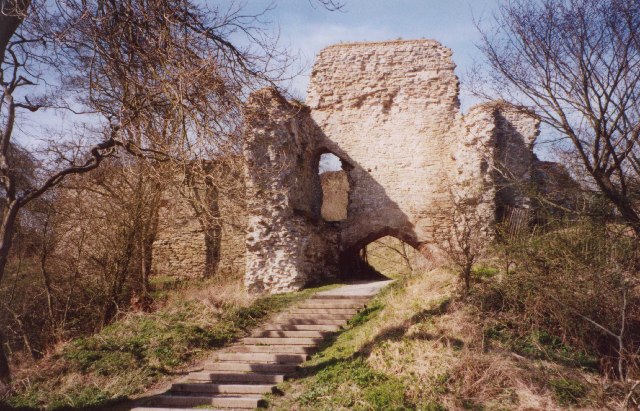
Wigmore Castle is a ruined castle which is barely visible from the village of Wigmore in the northwest region of Herefordshire, England. Wigmore Castle was founded after the Norman Conquest, probably 1070, by William fitzOsbern, 1st Earl of Hereford (1033-1071), my 30th GGF, and a close associate of William the Conqueror. FitzOsbern was killed in Flanders in 1071, and his son Roger de Breteuil took part in the Revolt of the Earls in 1075; after the Earl's subsequent defeat, William I seized the castle and gave it to another of his supporters, Ranulph de Mortimer (or Ralph de Mortimer). From this time on Wigmore became the head of the barony of the Mortimers. The Mortimers were my 22 GGparents through my 28th GGparents. It has been in a state of decay since the 16th Century. http://en.wikipedia.org/wiki/Wigmore_Castle

Wilton Castle, Ross-on-Wye, Herefordshire, England- 12th-century Norman castle- The castle was finally destroyed in the English Civil War, (1642–1651). - Reginald, 1st Lord Baron Wilton de Grey and Lady Maud, Matilda FitzHugh, Baroness Wilton de Grey, (1312-)-my 20th GGF and GGM- lived there. http://en.wikipedia.org/wiki/Wilton_Castle,
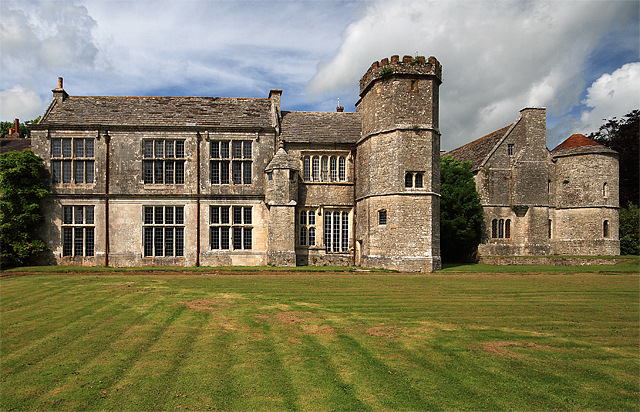
Wolfeton House, Wolveton House, is an early Tudor and Elizabethan manor house in Dorset, England. Sir John Trenchard III, (1453-1502), was my 15th GGF, whose family built it. http://en.wikipedia.org/wiki/Wolfeton_House
Woodstock Palace was a royal residence in the English town of Woodstock, Oxfordshire.[1]
Henry I of England (my 24th GGF) built a hunting lodge here and in 1129 he built 7 miles (11 km) of walls to create the first enclosed park, where lions and leopards were kept. The lodge became a palace under Henry's grandson, Henry II, who spent time here with his mistress, Rosamund Clifford.[1]
Important events that took place at the palace include:
- The marriage of William the Lion, king of Scots to Ermengarde de Beaumont in 1186
- The signing of the Treaty of Woodstock between Henry III of England and Llewelyn the Last (1247)[2]
- The birth of Edmund, youngest son of King Edward I of England (1301)
- The birth of Edward, the Black Prince (1330)
- The marriage of Mary Plantagenet, daughter of Edward III of England, to John IV, Duke of Brittany (1361)
- Imprisonment of the future Queen Elizabeth I of England (1554–58)[1]
King James and Anne of Denmark came to Woodstock in September 1603 during a time of plague.[3] Sir Robert Cecil criticised the building as, "unwholsome, all the house standing upon springs. It is unsavoury, for there is no savour but of cows and pigs. It is uneaseful, for only the King and Queen with the privy chamber ladies and 3 or 4 of Scottish council are lodged in the house".[4] The court was at Woodstock again in September 1610.[5]
Woodstock Palace was mostly destroyed during the English Civil War, and the remaining stones were later used to build Blenheim Palace nearby
https://en.wikipedia.org/wiki/Woodstock_PalaceWorcester Castle was a Norman fortification built between 1068 and 1069 in Worcester, England by Urse d'Abetot (my 25th GGF) on behalf of William the Conqueror. The castle had a motte-and-bailey design and was located on the south side of the old Anglo-Saxon city, cutting into the grounds of Worcester Cathedral. Royal castles were owned by the king and maintained on his behalf by an appointed constable. At Worcester that role was passed down through the local Beauchamp family (my GGFs) on a hereditary basis, giving them permanent control of the castle and considerable power within the city. The castle played an important part in the wars of the 12th and early 13th century, including the Anarchy and the First Barons' War
https://en.wikipedia.org/wiki/Worcester_Castle
















































